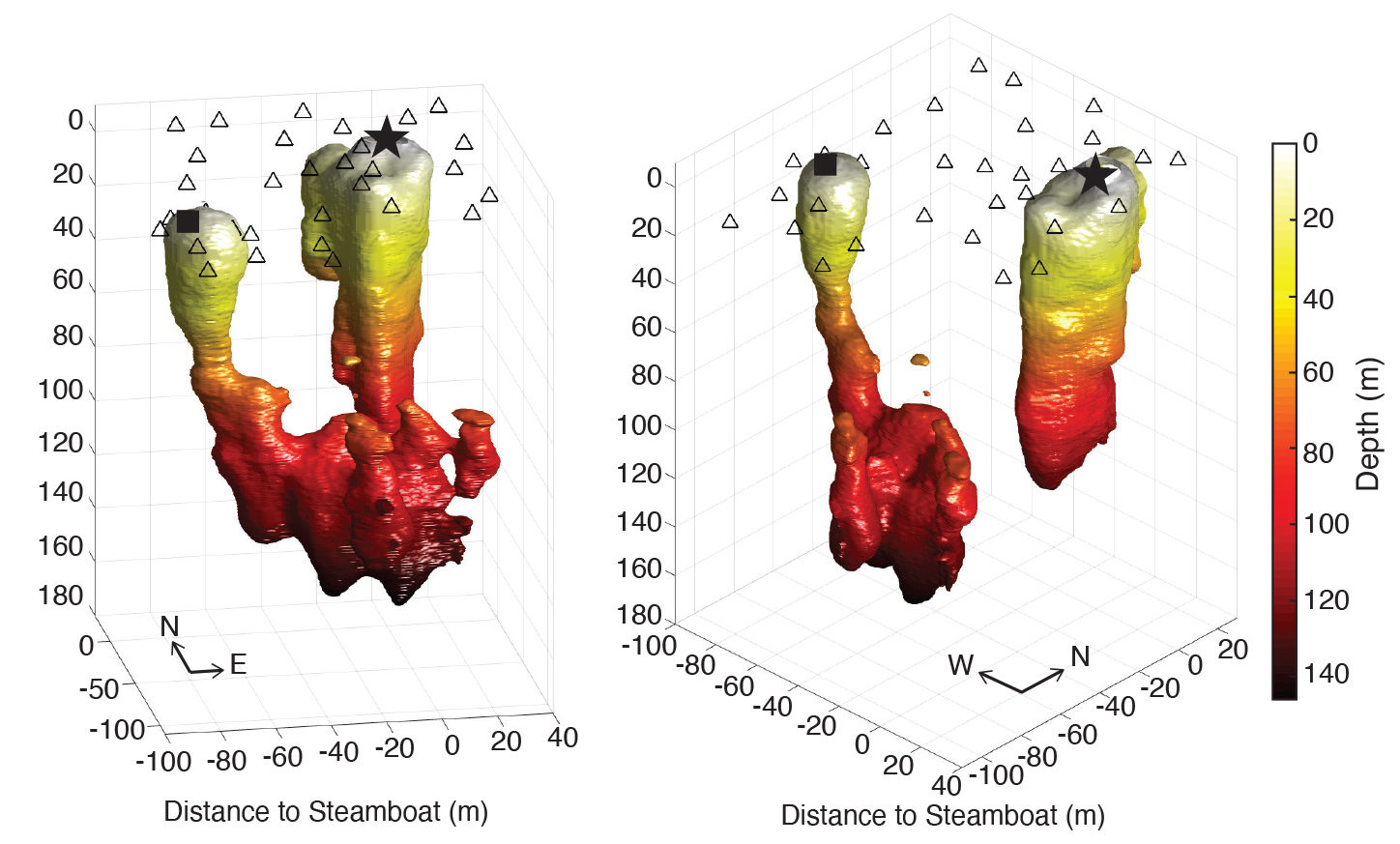The University of Utah has been studying the geology and seismology of Yellowstone and its unique features for decades, so U scientists were ready to jump at the opportunity to get an unprecedented look at the workings of Steamboat Geyser. Their findings provide a picture of the depth of the geyser as well as a redefinition of a long-assumed relationship between the geyser and a nearby spring. The findings are published in the Journal of Geophysical Research—Solid Earth.
“We scientists don’t really know what controls a geyser from erupting regularly, like Old Faithful, versus irregularly, like Steamboat,” says Fan-Chi Lin, an associate professor with the Department of Geology and Geophysics. “The subsurface plumbing structure likely controls the eruption characteristics for a geyser. This is the first time we were able to image a geyser’s plumbing structure down to more than 325 feet (100 m) deep.”
Meet Steamboat Geyser
If you’re asked to name a Yellowstone geyser and “Old Faithful” is the only one that comes to mind, then you’re past due for an introduction to Steamboat. Recorded eruption heights reach up to 360 feet (110 m), tall enough to splash the top of the Statue of Liberty.
“Watching a major eruption of Steamboat Geyser is quite amazing,” says Jamie Farrell, a research assistant professor with the University of Utah Seismograph Stations. “The thing that I remember most is the sound. You can feel the rumble and it sounds like a jet engine. I already knew that Steamboat was the tallest active geyser in the world, but seeing it in major eruption blew me away.”
Unlike its famous cousin, Steamboat Geyser is anything but faithful. It’s only had three periods of sustained activity in recorded history—one in the 1960s, one in the 1980s and one that began in 2018 and continues today. But the current phase of geyser activity has already seen more eruptions than either of the previous phases.
Near Steamboat Geyser is a pool called Cistern Spring. Because Cistern Spring drains when Steamboat erupts, it’s been assumed that the two features are directly connected.
“With our ability to quickly deploy seismic instruments in a nonintrusive way, this current period is providing the opportunity to better understand the dynamics of Steamboat Geyser and Cistern Spring which goes a long way to help us understand eruptive behavior,” says Farrell.
Giving the geyser a CT scan
For several years now, U scientists have been studying the features of Yellowstone National Park, including Old Faithful, using small, portable seismometers. The football-sized instruments can be deployed by the dozens wherever the researchers need for up to one month per deployment in order to get a picture of what’s happening under the ground. Each slight small movement of the ground, even the periodic swells of crowds on Yellowstone’s boardwalks, is felt and recorded.
And just as doctors can use multiple X-rays to create a CT scan of the interior of a human body, seismologists can use multiple seismometers recording multiple seismic events (in this case, bubbling within the geyser’s superheated water column) to build a sort of image of the subsurface.
In the summers of 2018 and 2019, Farrell and colleagues collaborated with the National Park Service and placed 50 portable seismometers in an array around Steamboat Geyser. The 2019 deployment recorded seven major eruptions, with a range of inter-eruption periods of three to eight days apart, each providing a wealth of data.
Plumbing the depths
The results showed that the underground channels and fissures that comprise Steamboat Geyser extend down at least 450 feet (140 m). That’s much deeper than the plumbing of Old Faithful, which is around 260 feet (80 m).
The results didn’t show a direct connection between Steamboat Geyser and Cistern Spring, however.
“This finding rules out the assumption that the two features are connected with something like an open pipe, at least in the upper 140 meters,” says Sin-Mei Wu, a recently graduated doctoral student working with Lin and Farrell. That’s not to say that the two features are totally separate, though. The fact that the pool drains when Steamboat erupts suggests that they are still connected somehow, but probably through small fractures or pores in the rock that aren’t detectable using the seismic signals the researchers recorded. “Understanding the exact relationship between Steamboat and Cistern will help us to model how Cistern might affect Steamboat eruption cycles,” added Wu.
Will scientists eventually be able to predict when the geyser will erupt? Maybe, Wu says, with a better understanding of hydrothermal tremor and a long-term monitoring system. But, in the meantime, Wu says, this study is really just the beginning of understanding how Steamboat Geyser works.
“We now have a baseline of what eruptive activity looks like for Steamboat,” Lin pointed out. “When it becomes less active in the future, we can re-deploy our seismic sensors and get a baseline of what non-active periods look like. We then can continuously monitor data coming from real-time seismic stations by Steamboat and assess whether it looks like one or the other and get a more real-time analysis of when it looks like it is switching to a more active phase.”
Find the full study here.
Find this release and images here.


